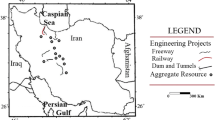Abstract
Aggregates are one of the most common materials used in engineering projects, and they are exposed to a variety of physical and chemical influences depending on the areas in which they are used. An aggregate should generally be hard, durable, uniform and clean, as well as highly abrasion-resistant. It must not contain harmful substances that can cause alkali-silica reactions. One of the most important properties for determining the quality of an aggregates is its abrasion resistance; the best known and most widely applied test used to measure abrasion resistance is the Los Angeles abrasion test (LA). Although the relationship between rock properties and LA has been investigated by some researchers, the relations between other aggregate strength properties and LA has not been clearly defined. In this study, thirty-nine igneous rock aggregates were tested to measure the quality of the aggregates and to determine the relationships between the LA values and the mechanical-physical properties of the aggregates. The LA values of the tested aggregates ranged from 16.13 to 58.9%. Both simple and multiple regression analysis techniques were used to evaluate in detail the test results obtained from the experiments. The LA value was estimated with the help of some aggregate tests (rock impact hardness-RIHN, coefficient of rock strength-CRS and aggregate crushing value-ACV, etc.) which can be done by using small amounts of the aggregates and relatively simple test tools. The aim of this study is to estimate in a practical way, the abrasion resistance of the aggregates with the help of these correlations, which were obtained by using relatively simple tests. The regression analyses (simple and multiple) indicated strong correlations between LA and mechanical tests of aggregate.



Similar content being viewed by others
References
Al-Harthi AA (2001) A field index to determine the strength characteristics of crushed aggregate. Bull Eng Geol Env 60(3):193–200
ASTM (2006) Resistance to degradation of small-size coarse aggregate by abrasion and impact in the Los Angeles machine. ASTM designation C-131-01. American Society for Testing Materials, Philadelphia
Ballivy G, Dayre M (1984) The mechanical behaviour of aggregates related to physicomechanical properties of rocks. Int Assoc Eng Geol Bull 29:339–342
British Standards Institution (1990a) Methods for determination of aggregate crushing value (ACV). BS 812–110. BSI, London
British Standards Institution (1990b) Methods for determination of aggregate impact value (AIV). BS 812–112. BSI, London
Cargill JS, Shakoor A (1990) Evaluation of empirical methods for measuring the uniaxial compressive strength of rock. Int J Rock Mech Min Sci Geomech Abstr 27(6):495–503
Evans I, Pomeroy CD (1966) The strength, fracture and workability of coal. Pergamon Press, London
Gandhi PM, Lytton RL (1984) Evaluation of aggregates for acceptance in asphalt paving mixtures. J Assoc Asph Paving Technol 53
ISRM (1981) In: Brown ET (ed) ISRM suggested methods-rock characterization testing and monitoring. Pergamon Press, Oxford 211 p
Kahraman S, Fener M (2007) Predicting the Los Angeles abrasion loss of rock aggregates from the uniaxial compressive strength. Mater Lett 61(26):4861–4865
Kahraman S, Fener M (2008) Electrical resistivity measurements to predict abrasion resistance of rock aggregates. Bull Mater Sci 31(2):179–184
Kahraman S, Gunaydin O (2007) Empirical methods to predict the abrasion resistance of rock aggregates. Bull Eng Geol Environ 66(4):449–455
Kahraman S, Toraman OY (2008) Predicting Los Angeles abrasion loss of rock aggregates from crushability index. Bull Mater Sci 31(2):173–177
Kasim M, Shakoor A (1996) An investigation of the relationship between uniaxial compressive strength and degradation for selected rock types. Eng Geol 44(1–4):213–227
Kazi A, Al-Mansour ZR (1980a) Empirical relationship between Los Angeles abrasion and Schmidt hammer strength tests with application to aggregate around Jeddah. Q J Eng Geol 13(1):45–52
Kazi A, Al-Mansour ZR (1980b) Influence of geological factors on abrasion and soundness characteristics of aggregates. Eng Geol 15(3–4):195–203
Moavenzadeh F, Goetz WH (1963) Aggregate degradation in bituminous mixtures. Highw Res Rec 24
Ozcelik Y (2011) Predicting Los Angeles abrasion of rocks from some physical and mechanical properties. Sci Res Essays 6(7):1612–1619
Paone J, Madson D, Bruce WE (1969) Drillability studies: laboratory percussive drilling. USBM RI 7300
Rabia H, Brook W (1980) An empirical equation for drill performance prediction. In: Proceedings of the 21st US symposium on rock mechanics. Univ Missouri-Rolla, pp 103
Shakoor A, Bonelli RE (1991) Relationship between petrographic characteristics, engineering index properties, and mechanical properties of selected sandstones. Bull Assoc Eng Geol 28(1):55–71
Shakoor A, Brown CL (1996) Development of a quantitative relationship between unconfined compressive strength and Los Angeles abrasion loss for carbonate rocks. Bull Eng Geol Environ 53(1):97–103
Tandanand S, Unger HF (1975) Drillability determination: a drillability index of percussive drills. USBM RI 8073
Ugur I, Demirdag S, Yavuz H (2010) Effect of rock properties on the Los Angeles abrasion and impact test characteristics of the aggregates. Mater Char 61(1):90–96
Wu Y, Parker F, Kandhal K (1998) Aggregate toughness/abrasion resistance and durability/soundness tests related to asphalt concrete performance in pavements. J Transp Res Board 1638:85–93
Author information
Authors and Affiliations
Corresponding author
Rights and permissions
About this article
Cite this article
Teymen, A. Estimation of Los Angeles abrasion resistance of igneous rocks from mechanical aggregate properties. Bull Eng Geol Environ 78, 837–846 (2019). https://doi.org/10.1007/s10064-017-1134-0
Received:
Accepted:
Published:
Issue Date:
DOI: https://doi.org/10.1007/s10064-017-1134-0




